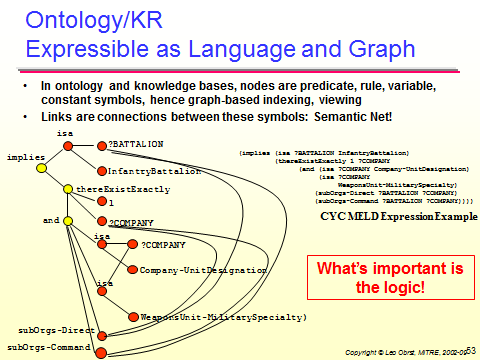|
Leo, Todd, Every language can be represented graphically, though a given ontology language may not have implemented such a visualization. Here is my contrived graph of a Cyc Meld _expression_: 
Sent: Tuesday, April 03, 2012 10:52 AM To: John F Sowa Cc: OpenOntologyRepository-discussion Subject: Re: [oor-forum] OOR Architecture & API Workshop-XI - Tue 2012.03.20 John, On 3/20/2012 1:11 PM, Todd J Schneider wrote: > We discovered we had an implicit assumption that the common notions > of 'class/concept' and 'relations/properties' would > be valid for all representation languages. That is why I prefer to use a foundational logic with a minimum amount of terminology. Then all other terms can be defined, explained, or related to one another through the basic terms. You don't even have to agree on a specific logic or notation. Just use the following minimal set of terms, which can be related directly to many different logics. Minimal set: 1. Boolean operators. 2. Quantifiers (some & every, or the symbols for them). 3. Relations or predicates. 4. Sets. Translations: 1. Use 'monadic relation' for every occurrence of property, attribute, characteristic, feature, facet, concept, or type. 2. Use 'dyadic relation' instead of role. 3. Treat a class as a composite of a type and a set. Then you can clearly distinguish whether you mean the monadic relation that specifies the type or the set of all instances of that type. 4. Instead of using the modal terms necessary, mandatory, required, or obligatory, state some constraints that must be true. Something is necessary, mandatory, required, or obligatory if it is implied by the constraints. It is possible, optional, or permissible if it is consistent with the constraints. John _________________________________________________________________ Message Archives: http://ontolog.cim3.net/forum/oor-forum/ Subscribe: mailto:oor-forum-join@xxxxxxxxxxxxxxxx Config/Unsubscribe: http://ontolog.cim3.net/mailman/listinfo/oor-forum/ Shared Files: http://ontolog.cim3.net/file/work/OOR/ Wiki: http://ontolog.cim3.net/cgi-bin/wiki.pl?OpenOntologyRepository _________________________________________________________________ Message Archives: http://ontolog.cim3.net/forum/oor-forum/ Subscribe: mailto:oor-forum-join@xxxxxxxxxxxxxxxx Config/Unsubscribe: http://ontolog.cim3.net/mailman/listinfo/oor-forum/ Shared Files: http://ontolog.cim3.net/file/work/OOR/ Wiki: http://ontolog.cim3.net/cgi-bin/wiki.pl?OpenOntologyRepository (01) |